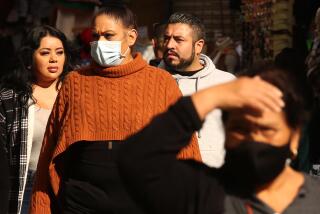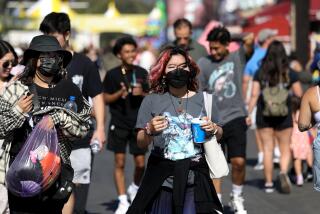How to holiday shop as safely as possible amid a pandemic

- Share via
With Christmas fast approaching, malls and other retail centers are seeing a burst of holiday shopping.
But this rite of the season comes amid an unprecedented COVID-19 crisis, which in recent weeks has begun to hit some shopping malls hard.
Local and state governments imposed restrictions on shopping, including occupancy limits and mask and social distancing rules. Still, there has been growing alarm at the size of the crowds at some centers.
“We’ve all seen images of people out and about. Lots of people in parks. Images of busy shopping centers and retail centers. And we are very worried about what this could mean in the days and weeks to come,” L.A. County Health Services Director Dr. Christina Ghaly said this week. “If you’re still out there shopping for your loved ones for this holiday season, or you’re planning a holiday get-together, then you are missing the gravity of the situation that is affecting hospitals across Los Angeles County and California and this nation.”
Officials have urged people to avoid last-minute holiday shopping in person if possible. If people do visit stores, they should be prepared to leave if stores seem too crowded or are not following proper protocols, said L.A. County chief medical officer Dr. Jeffrey Gunzenhauser. Many experts also recommended minimizing time in the store, as longer exposures to infected people increase the likelihood of transmission.
Gunzenhauser pointed out that customers are more likely to be in close contact with other shoppers than with employees, so community prevalence may be a better indicator of risk than whether a store‘s staff recently suffered an outbreak. Currently, 1 in 80 Angelenos are believed to be infectious with COVID-19.
“Our first recommendation is stay home as much as possible,” he said.
How to stay as safe as possible? Here are some guidelines from the Centers for Disease Control:
For shoppers
- Wear a mask in public settings and when around people who don’t live in your household, especially when social is distancing is difficult.
- When you do have to visit in person, go during hours when fewer people will be there (for example, early morning or late night).
- If you are at higher risk for severe illness, find out whether the store has special hours for people at higher risk. If it does, try to shop during those hours.
- If you normally bring your own reusable shopping bags, ensure they are cleaned before each use. Some locations have temporarily banned the use of reusable shopping bags during the COVID-19 pandemic, so check your state, local, store or market policies before bringing reusable bags.
- Disinfect the shopping cart, using disinfecting wipes if available.
- Do not touch your eyes, nose or mouth with unwashed hands.
- Stay at least 6 feet away from others while shopping and in lines.
- Use marked entry or exit points, and follow any signs or floor markings designed to keep people at least 6 feet apart.
- Touch only products that you plan to buy, if possible.
- Consider not consuming samples or purchasing food or drink items from self-service stations.
- If possible, use touchless payment (pay without touching money, a card, or a keypad). If you must handle money, a card or use a keypad, use hand sanitizer right after paying.
For retail workers
- Notify your supervisor and stay home if you’re having symptoms (fever, cough, or shortness of breath).
- Follow CDC-recommended steps if you are sick. You should not return to work until the criteria to discontinue home isolation are met, in consultation with healthcare providers and state and local health departments.
- Follow CDC recommended precautions and notify your supervisor if you are well but have a sick family member at home with COVID-19.
- Limit close contact with others and maintain a distance of at least 6 feet, when possible.
- Remind customers to maintain 6 feet distance from workers and other customers with verbal announcements on the loudspeaker and written signage.
- The CDC recommends wearing cloth face coverings in public settings where other social distancing measures are difficult to maintain, especially in areas of significant community-based transmission. Cloth face coverings may prevent people who don’t know they have the virus from transmitting it to others. These face coverings are not surgical masks or respirators and are not appropriate substitutes for them in workplaces where masks or respirators are recommended or required.
- Encourage customers to use touchless payment options, when available. Minimize handling cash, credit cards, reward cards and mobile devices, where possible.
- When exchanging paper and coin money:
- Do not touch your face afterward.
- Ask customers to place cash on the counter rather than directly into your hand.
- Place money directly on the counter when providing change back to customers.
- Wipe counter between each customer at checkout.
- Clean and disinfect frequently touched surfaces such as workstations, cash registers, payment terminals, door handles, tables, and countertops on a routine basis. Follow the directions on the cleaning product’s label and clean hands afterward.
- Practice proper hand hygiene. This is an important infection control measure. With appropriate hand hygiene, gloves are not necessary for workers who are not involved in food preparation. Wash your hands regularly with soap and water for at least 20 seconds. An alcohol-based hand sanitizer containing at least 60% alcohol can be used, but not as a substitute for cleaning hands with soap and water.
- Key times to clean hands include:
- Before, during, and after preparing food
- Before eating food
- After using the toilet
- After blowing your nose, coughing, or sneezing
- After putting on, touching, or removing cloth face coverings
- Additional workplace-specific times to clean hands include:
- Before and after work shifts and periodically throughout shift
- Before and after work breaks
- After touching money or objects that have been handled by customers, such as reusable grocery bags
- Before putting on and taking off disposable gloves when performing food prep
- Avoid contact with body fluids.
- Do not touch your eyes, nose, or mouth.
- Use tissues when you cough, sneeze, or touch your face. Throw used tissues in the trash.
So what are the L.A. County rules for retailers? Here is a summary from the Los Angeles County Department of Public Health:
- Limit occupancy to 20% of the overall mall or shopping center capacity.
- Implement a system for monitoring shopping center occupancy.
- Prohibit eating or drinking in the shopping center.
- Institute special hours for seniors and others with chronic conditions or compromised immune systems.
- Holiday-oriented activities or events, including photos with Santa, are not permitted per the Regional Stay at Home Order.
- Face coverings must be worn by employees working in cubicles, including cubicles equipped with partitions. This is a temporary measure.
- At all times when eating or drinking, employees must maintain a 6-foot distance from others and should do so outdoors, if possible. Eating or drinking at a cubicle or workstation is preferred to eating in a break room.
- Nonessential operations at shopping centers to close between the hours of 10 p.m. and 5 a.m.
- Outdoor dining areas must close. Restaurants may offer takeout, drive-through or delivery.
More to Read
Sign up for Essential California
The most important California stories and recommendations in your inbox every morning.
You may occasionally receive promotional content from the Los Angeles Times.











